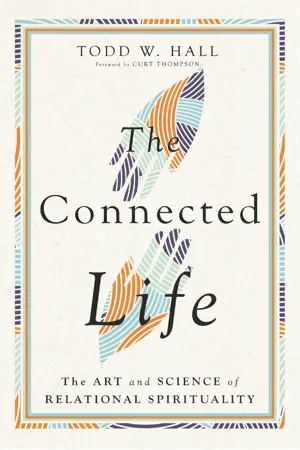SIGNS OF A CONNECTION CRISIS
My parents separated in 1979, right at the end of an epidemic period of divorce. My family is a prototypical example from this period. From the outside we were a seemingly normal middle class family living in the suburb of Irvine, California—two parents, two kids, and two cars. On the inside, however, we were a family falling apart and disconnecting from each other, extended family, and community. In Judith Wallerstein’s landmark study of the children of divorce, which started in 1971 and spanned twenty-five years, Wallerstein and her colleagues noted: “Since 1970, at least a million children per year have seen their parents divorce—building a generation of Americans that has now come of age.”1 Millions of families were being torn apart—some silently—leaving the children with a legacy of disconnection despite the widespread, misguided belief that children would quickly rebound from divorce and experience no permanent psychological damage. As of the publication of Wallerstein’s book in 2000, this group represented one-quarter of the adults in the United States who had reached their forty-fourth birthday.
The rise of divorce is just one indicator of a broader connection crisis in our culture that has emerged over the last fifty years.2 Over this time period we’ve also seen a decline in emotional well-being in parallel with decreasing social connection. One trend that illustrates this is the increasing rates of depression in recent decades. Psychologist Martin Seligman stated: “The rate of depression over the last two generations has increased roughly tenfold.”3 Along with depression, we’ve seen an alarming increase in loneliness in recent decades. In a 2017 article in Harvard Business Review, former US surgeon general Vivek Murthy stated, “Loneliness is a growing health epidemic.”4 He goes on to note that, despite being more technologically connected than ever, rates of loneliness have more than doubled since the 1980s. In addition to general social isolation, over half of US adults recently reported feeling like no one knows them well.5
There are many interrelated factors that led to our current connection crisis. In some ways they can all be tied back to cultural trends that steadily grew in the last half of the twentieth century—the collective consciousness of the American mind about what constitutes the “good life”—what we might call “the American ideal.” This set of ideologies, values, and beliefs that constitute the American ideal include extreme forms of individualism and materialism. This “good life” values independence over friendship, personal comfort over commitment to others, solitary achievements over the common good, and economic success over social and emotional well-being. We can see this set of ideologies in the breakdown of the family and the decline of community—two major trends that have contributed to our connection crisis.
THE FRAGMENTATION OF THE FAMILY STRUCTURE
The family unit, and parent-child relationships in particular, are the most important social context in which children develop attachment bonds. It’s in these close relationships that children first learn how to connect to people and God and to develop a sense of morality.
From the mid-1960s through about 1990, the family as a social unit got steadily weaker on numerous counts. The divorce rate more than doubled from 1960 to 1980 (a 136 percent increase). This resulted in large part from dramatic changes in the cultural winds and family law in California in the late 1960s. “A series of statewide task forces,” notes Wallerstein, “recommended that men and women seeking divorce should no longer be required to prove that their spouse was unfaithful, unfit, cruel, or incompatible.”6 As a result, in 1969 Governor Ronald Reagan signed the no-fault divorce law into effect, and within a few years no-fault divorce laws spread like a virus throughout all fifty states.
Even before my parents’ divorce, their marriage had declined to nothing but a shell of a lifelong partnership. They didn’t argue in front of us, but there was a certain emptiness I felt in our family. My parents’ relationship wasn’t healthy and authentic. I didn’t see them express affection toward each other, engage in meaningful dialogue, laugh together, or do things together. This, of course, set the tone for the family; we rarely did things together. As I mentioned, my mom also suffered from emotional and physical illnesses, partly due to the very dysfunctional and fragmented family in which she grew up. The attachment bond developed with my mom was fragile and insecure, and this would come to impact all my significant relationships. The most important social context in which I learned how to connect was unhealthy, which impacted my ability to connect to God and others. Sadly, this is true for millions of Gen Xers and Millennials, and Gen Zers who are now coming of age.
I didn’t have to look far to see this same pattern in my friends. In fifth grade, we moved a few houses down from the Peterson family. They had five kids and I became close friends with Johnny and Jeremy. Their family was, in some ways, more dysfunctional than mine. On the surface theirs was also a “normal” middle class family in suburbia, but under the surface was deep fragmentation and chaos. Their mom was an alcoholic, and her alcoholism grew worse as we got older. She was often drunk when I was at the house, and she was verbally and emotionally abusive to her kids. I remember her screaming at the kids and sometimes at me, often for no apparent reason. On a few occasions she threw things at her kids. I remember one afternoon when she threw a frying pan across the room at her son Gary. Thankfully, she missed. The summer after my fifth-grade year, the Petersons divorced. By comparison, I felt my family was calm and “normal.” My sister and I lived with my dad who was secure, stable, and calm compared to Mrs. Peterson, but he was still disconnected in some ways. This was the norm I grew up with—divorced, chaotic families filled with all kinds of disconnection.
My experience is a reflection of trends in recent decades related to divorce and family households. The probability of divorce increased steadily from the early 1900s through about 1990 and then plateaued.7 Even with this plateau, nearly all studies conducted through about 2005 converged in suggesting that the lifetime probability of marital disruption is between 40 percent and 50 percent.8 In fact, well over half of my childhood friends’ parents went through a divorce. Among my inner circle of friends growing up, two-thirds were from divorced families.
A related concerning trend is that two-parent, single-household families declined in the decade of the 2000s.9 This is due to divorce and increased rates of childbearing in unmarried, cohabitating unions.10 The level of family dissolution has continued since then due to the fact that informal unions are less stable than marriages.11
The breakdown of the family has taken its toll at a societal level. In addition, although the legal act of divorce may be an event, the effects of pre-divorce marital conflict and divorce are often long lasting and impact a person’s emotional security and sense of connection to God. This was certainly the case for me.
The effects of divorce and family dissolution stem from two sources: changes in family structure (e.g., multiple households, stepparents, lack of contact with non-residential parent), and the relational struggles of parents, which are associated with unhealthy ways of relating to children. I experienced both of these in my own life and have worked with many clients who’ve experienced these negative effects of divorce. As I mentioned, after my parents’ divorce, my sister and I lived with my dad. We would see my mom occasionally on weekends, but we had relatively little contact with her. Life was forever different after the divorce.
The relationship characteristics that predict divorce—domestic violence, frequent conflict, infidelity, weak commitment to marriage, and low levels of love and trust between spouses—all reflect unhealthy relational patterns among parents that presumably get passed down to children in the form of insecure attachment.12 Attachment relationships (to which we’ll return in part three) are relationships in which a child looks to a caregiver to provide physical and emotional comfort in times of distress, and a secure base, or sense of internal security, from which to explore the world. Insecure attachment comes in two basic varieties: (1) ambivalent, in which children are highly anxious, and (2) avoidant, in which children are emotionally shut down. Both types of insecure attachment are linked to negative developmental and social outcomes later in life, including one’s relationship with God.13 Several fascinating studies have shown that pregnant mothers’ attachment tendencies predict their children’s attachment tendencies at one year of age, suggesting that attachment is passed down from parent to child through emotional communication and relational interactions.14
While there was no violence or infidelity in my parents’ case, there was certainly conflict and lack of trust that reflected deeper attachment issues. I know very little of my mom’s background because we never visited her extended family, and both her parents died by the time I was two years old. I suspect she experienced a lot of suffering during her childhood. I believe my mom rarely talked about her past with us because it brought up too much unresolved pain. When I tried to have these conversations with her when I was in college and graduate school, she would either fall apart emotionally or get angry. She simply wasn’t capable of talking in a coherent and contained way about her past. This incoherence reflects an insecure attachment, which led to significant challenges in our relationship.
Consistent with research on attachment insecurities being passed down, in the past two decades research has generally shown that children with divorced parents, compared with those with continuously married parents, score lower on emotional, behavioral, social, health, and academic outcomes.15 This corroborates previous findings and indicates that the links between divorce and various aspects of child well-being have remained relatively stable across decades. Young adults with divorced parents also continue to experience negative effects from divorce. While they don’t necessarily show higher rates of clinical depression and anxiety, they do continue to experience a significant amount of emotional pain as a result of their parents’ divorce.16
For example, in one study these young adults reported that they were forced to take on adult responsibilities as a child, felt lonely during childhood, experienced family events and holidays as stressful, felt unsafe at home due to their fathers’ absence, missed their fathers, and felt torn between their parents’ households.17 I experienced many of these things as a young adult. I became the peacemaker in my family and took on a parental role with my mom much of the time. Family events and holidays were stressful and brought up a longing for the way things were supposed to be and sadness over the way things were.
The primary functions of the attachment bond—emotional comfort and security—are negatively impacted by the typical experiences of young adults from divorced and dysfunctional homes. This, in turn, has a negative impact on people’s experiences of God. If we can’t trust our parents, who we can see, to provide emotional support and security, how can we trust God, who we can’t see? Patterns of interactions with our attachment figures ge...



